A Hybrid Self-Seeded Ti:sapphire Laser with a Pumping Scheme Based on Spectral Beam Combination of Continuous Wave Diode and Pulsed DPSS Lasers
Abstract
1. Introduction
2. Materials and Methods
2.1. Laser Setup
2.2. Operation and Stabilization
3. Results
3.1. Error Signals and Locking Performance
3.2. Output Power and Efficiency
3.3. Linewidth Measurement
3.4. Frequency Scanning
4. Discussion and Conclusions
Author Contributions
Funding
Institutional Review Board Statement
Informed Consent Statement
Data Availability Statement
Conflicts of Interest
Abbreviations
| CW | continuous wave |
| DPSS | Diode-pumped Solid-state |
| FOM | Figure of Merit |
| FPI | Fabry Pérot Interferometer |
| FSR | Free Spectral Range |
| FWHM | Full Width at Half Maximum |
| HR | High Reflector |
| HV | High Voltage |
| Nd:YAG | neodymium-doped yttrium aluminum garnet |
| OC | Output Coupler |
| PD | Photodiode |
| PID | Proportional-Integral-Derivative |
| PRR | pulse repetition rate |
| PZ | Piezo |
| SHG | second harmonic generation |
| SN | signal-to-noise |
| TGG | Terbium Gallium Garnet |
| Ti:sapphire | titanium-doped sapphire |
References
- Gabrielse, G.; Glowacz, B.; Grzonka, D.; Hamley, C.D.; Hessels, E.A.; Jones, N.; Khatri, G.; Lee, S.A.; Meisenhelder, C.; Morrison, T.; et al. Lyman-α source for laser cooling antihydrogen. Opt. Lett. 2018, 43, 2905–2908. [Google Scholar] [CrossRef] [PubMed]
- Pohl, R.; Antognini, A.; Nez, F.; Amaro, F.D.; Biraben, F.; Cardoso, J.M.R.; Covita, D.S.; Dax, A.; Dhawan, S.; Fernandes, L.M.P.; et al. The size of the proton. Nature 2010, 466, 213–216. [Google Scholar] [CrossRef] [PubMed]
- Krauth, J.J.; Schuhmann, K.; Ahmed, M.A.; Amaro, F.D.; Amaro, P.; Biraben, F.; Chen, T.L.; Covita, D.S.; Dax, A.J.; Diepold, M.; et al. Measuring the α-particle charge radius with muonic helium-4 ions. Nature 2021, 589, 527–531. [Google Scholar] [CrossRef] [PubMed]
- Wendt, K.; Mattolat, C.; Gottwald, T.; Kron, T.; Raeder, S.; Rothe, S.; Schwellnus, F.; Tomita, H. Hyperfine structure and isotope shift in the 3s2 3p2 3P0,1,2→ 3s2 3p4p 3P0,1,2 transitions in silicon by Doppler-free in-source two-photon resonance-ionization spectroscopy. Phys. Rev. A 2013, 88, 052510. [Google Scholar] [CrossRef]
- Chrysalidis, K.; Wilkins, S.; Heinke, R.; Koszorus, A.; De Groote, R.; Fedosseev, V.; Marsh, B.; Rothe, S.; Garcia Ruiz, R.; Studer, D.; et al. First demonstration of Doppler-free 2-photon in-source laser spectroscopy at the ISOLDE-RILIS. Nucl. Instrum. Methods Phys. Res. B 2020, 463, 476–481. [Google Scholar] [CrossRef]
- Ferrer, R.; Barzakh, A.; Bastin, B.; Beerwerth, R.; Block, M.; Creemers, P.; Grawe, H.; de Groote, R.; Delahaye, P.; Fléchard, X.; et al. Towards high-resolution laser ionization spectroscopy of the heaviest elements in supersonic gas jet expansion. Nat. Commun. 2017, 8, 14520. [Google Scholar] [CrossRef]
- Granados, C.; Creemers, P.; Ferrer, R.; Gaffney, L.P.; Gins, W.; de Groote, R.; Huyse, M.; Kudryavtsev, Y.; Martínez, Y.; Raeder, S.; et al. In-gas laser ionization and spectroscopy of actinium isotopes near the N = 126 closed shell. Phys. Rev. C 2017, 96, 054331. [Google Scholar] [CrossRef]
- Ferrer, R.; Verlinde, M.; Verstraelen, E.; Claessens, A.; Huyse, M.; Kraemer, S.; Kudryavtsev, Y.; Romans, J.; Van den Bergh, P.; Van Duppen, P.; et al. Hypersonic nozzle for laser-spectroscopy studies at 17 K characterized by resonance-ionization-spectroscopy-based flow mapping. Phys. Rev. Res. 2021, 3, 043041. [Google Scholar] [CrossRef]
- Sonnenschein, V.; Moore, I.D.; Raeder, S.; Reponen, M.; Tomita, H.; Wendt, K. Characterization of a pulsed injection-locked Ti:sapphire laser and its application to high resolution resonance ionization spectroscopy of copper. Laser Phys. 2017, 27, 085701. [Google Scholar] [CrossRef]
- Studer, D.; Ulrich, J.; Braccini, S.; Carzaniga, T.S.; Dressler, R.; Eberhardt, K.; Heinke, R.; Köster, U.; Raeder, S.; Wendt, K. High-resolution laser resonance ionization spectroscopy of 143–147Pm. Eur. Phys. J. A 2020, 56, 69. [Google Scholar] [CrossRef]
- Kessler, T.; Tomita, H.; Mattolat, C.; Raeder, S.; Wendt, K. An injection-seeded high-repetition rate Ti:Sapphire laser for high-resolution spectroscopy and trace analysis of rare isotopes. Laser Phys. 2008, 18, 842. [Google Scholar] [CrossRef]
- Metzendorf, S. 10 W-Average-Power Single-Frequency Ti:sapphire Laser with Tuning Agility—A Breakthrough in High-Resolution 3D Water-Vapor Measurement. Ph.D. Thesis, Universität Hohenheim, Stuttgart, Germany, 2018. [Google Scholar]
- Wagner, G.; Behrendt, A.; Wulfmeyer, V.; Späth, F.; Schiller, M. High-power Ti:sapphire laser at 820nm for scanning ground-based water vapor differential absorption lidar. Appl. Opt. 2013, 52, 2454–2469. [Google Scholar] [CrossRef] [PubMed]
- Hannemann, S.; van Duijn, E.J.; Ubachs, W. A narrow-band injection-seeded pulsed titanium:sapphire oscillator-amplifier system with on-line chirp analysis for high-resolution spectroscopy. Rev. Sci. Instrum. 2007, 78, 103102. [Google Scholar] [CrossRef] [PubMed]
- Zheng, J.; Katsuragawa, M. Freely designable optical frequency conversion in Raman-resonant four-wave-mixing process. Sci. Rep. 2015, 5, 8874. [Google Scholar] [CrossRef] [PubMed]
- Chemnitz, M.; Baumgartl, M.; Meyer, T.; Jauregui, C.; Dietzek, B.; Popp, J.; Limpert, J.; Tünnermann, A. Widely tuneable fiber optical parametric amplifier for coherent anti-Stokes Raman scattering microscopy. Opt. Express 2012, 20, 26583–26595. [Google Scholar] [CrossRef]
- Lefrancois, S.; Fu, D.; Holtom, G.R.; Kong, L.; Wadsworth, W.J.; Schneider, P.; Herda, R.; Zach, A.; Xie, X.S.; Wise, F.W. Fiber four-wave mixing source for coherent anti-Stokes Raman scattering microscopy. Opt. Lett. 2012, 37, 1652–1654. [Google Scholar] [CrossRef]
- Thariyan, M.P.; Bhuiyan, A.H.; Meyer, S.E.; Naik, S.V.; Gore, J.P.; Lucht, R.P. Dual-pump coherent anti-Stokes Raman scattering system for temperature and species measurements in an optically accessible high-pressure gas turbine combustor facility. Meas. Sci. Technol. 2010, 22, 015301. [Google Scholar] [CrossRef]
- Hamilton, C.E. Single-frequency, injection-seeded Ti:sapphire ring laser with high temporal precision. Opt. Lett. 1992, 17, 728–730. [Google Scholar] [CrossRef]
- Drever, R.W.P.; Hall, J.L.; Kowalski, F.V.; Hough, J.; Ford, G.M.; Munley, A.J.; Ward, H. Laser phase and frequency stabilization using an optical resonator. Appl. Phys. B 1983, 31, 97–105. [Google Scholar] [CrossRef]
- Tomita, H.; Mattolat, C.; Kessler, T.; Raeder, S.; Schwellnus, F.; Wendt, K.; Watanabe, K.; Iguichi, T. Ultra Trace Determination Scheme for 26 Al by High-Resolution Resonance Ionization Mass Spectrometry using a Pulsed Ti:Sapphire Laser. J. Nucl. Sci. Technol. 2008, 45, 37–42. [Google Scholar] [CrossRef]
- Henderson, S.W.; Yuen, E.H.; Fry, E.S. Fast resonance-detection technique for single-frequency operation of injection-seeded Nd:YAG lasers. Opt. Lett. 1986, 11, 715–717. [Google Scholar] [CrossRef] [PubMed]
- Walther, T.; Larsen, M.P.; Fry, E.S. Generation of Fourier-transform-limited 35-ns pulses with a ramp-hold-fire seeding technique in a Ti:sapphire laser. Appl. Opt. 2001, 40, 3046–3050. [Google Scholar] [CrossRef]
- Raymond, T.; Smith, A. Two-frequency injection-seeded Nd:YAG laser. IEEE J. Quantum Electron. 1995, 31, 1734–1737. [Google Scholar] [CrossRef]
- Tamura, K. Properties of a Pulsed Ti:Sapphire Laser Oscillator with an Extended Standing-Wave Cavity. J. Nucl. Sci. Technol. 2009, 46, 316–319. [Google Scholar] [CrossRef][Green Version]
- Suzuki, H.; Kuribayashi, O.; Kannari, F. Synchronous dual-wavelength operation of a self-injection-seeded narrow-linewidth flash-lamp-pumped Q-switched Ti:Al2O3 laser. Opt. Lett. 1997, 22, 1710–1712. [Google Scholar] [CrossRef]
- Li, R.; Lassen, J.; Rothe, S.; Teigelhöfer, A.; Mostamand, M. Continuously tunable pulsed Ti:Sa laser self-seeded by an extended grating cavity. Opt. Express 2017, 25, 1123–1130. [Google Scholar] [CrossRef] [PubMed]
- Barnes, N.; Williams, J.; Barnes, J.; Lockard, G. A self-injection locked, Q-switched, line-narrowed Ti:Al2O3 laser. IEEE J. Quantum Electron. 1988, 24, 1021–1028. [Google Scholar] [CrossRef]
- Tamura, K. Single-longitudinal-mode scan of a pulsed double-grating Ti:sapphire oscillator. Appl. Opt. 2007, 46, 5924–5927. [Google Scholar] [CrossRef]
- Raymond, T.D.; Esherick, P.; Smith, A.V. Widely tunable single-longitudinal-mode pulsed dye laser. Opt. Lett. 1989, 14, 1116–1118. [Google Scholar] [CrossRef]
- Binks, D.J.; Gloster, L.A.W.; King, T.A.; McKinnie, I.T. Frequency locking of a pulsed single-longitudinal-mode laser in a coupled-cavity resonator. Appl. Opt. 1997, 36, 9371–9377. [Google Scholar] [CrossRef]
- Crawford, T.; Lowrie, C.; Thompson, J.R. Prelase stabilization of the polarization state and frequency of a Q-switched, diode-pumped, Nd:YAG laser. Appl. Opt. 1996, 35, 5861–5869. [Google Scholar] [CrossRef] [PubMed]
- Dai, W.; Jin, L.; Dong, Y.; Jin, G. Experimental Investigation of a High-repetition-rate Pr3+:YLF Laser with Single-frequency Oscillation. Curr. Opt. Photonics 2021, 5, 721–729. [Google Scholar] [CrossRef]
- Qing-Song, L.; Yuan, D.; Yu, L.; Xi-He, Z.; Yong-Ji, Y.; Guang-Yong, J. Effect of cavity length on low-energy single longitudinal mode pre-lase Q-switched laser. Opt. Laser Technol. 2017, 94, 165–170. [Google Scholar] [CrossRef]
- Backus, S.; Kirchner, M.; Durfee, C.; Murnane, M.; Kapteyn, H. Direct diode-pumped Kerr Lens 13 fs Ti:sapphire ultrafast oscillator using a single blue laser diode. Opt. Express 2017, 25, 12469–12477. [Google Scholar] [CrossRef] [PubMed]
- Song, D.H.; Seo, H.S. Spectrally combined three-diode-pumped compact femtosecond Ti:sapphire laser exceeding 1 W mode-locked power. Opt. Express 2021, 29, 32649–32657. [Google Scholar] [CrossRef]
- Durfee, C.G.; Storz, T.; Garlick, J.; Hill, S.; Squier, J.A.; Kirchner, M.; Taft, G.; Shea, K.; Kapteyn, H.; Murnane, M.; et al. Direct diode-pumped Kerr-lens mode-locked Ti:sapphire laser. Opt. Express 2012, 20, 13677–13683. [Google Scholar] [CrossRef]
- Rohrbacher, A.; Olarte, O.E.; Villamaina, V.; Loza-Alvarez, P.; Resan, B. Multiphoton imaging with blue-diode-pumped SESAM-modelocked Ti:sapphire oscillator generating 5 nJ 82 fs pulses. Opt. Express 2017, 25, 10677–10684. [Google Scholar] [CrossRef]
- Liu, H.; Sun, S.; Zheng, L.; Wang, G.; Tian, W.; Zhang, D.; Han, H.; Zhu, J.; Wei, Z. Review of laser-diode pumped Ti:sapphire laser. Microw. Opt. Technol. Lett. 2021, 63, 2135–2144. [Google Scholar] [CrossRef]
- Miao, Z.W.; Yu, H.J.; Zou, S.Z.; He, C.J.; Zhao, P.F.; Lou, B.J.; Lin, X.C. Low-threshold-intensity 3.8-W continuous-wave Ti:Sapphire oscillator directly pumped with green diodes. Appl. Phys. B 2021, 127, 105. [Google Scholar] [CrossRef]
- Roth, P.W.; Burns, D.; Kemp, A.J. Power scaling of a directly diode-laser-pumped Ti:sapphire laser. Opt. Express 2012, 20, 20629–20634. [Google Scholar] [CrossRef]
- Backus, S.; Kirchner, M.; Lemons, R.; Schmidt, D.; Durfee, C.; Murnane, M.; Kapteyn, H. Direct diode pumped Ti:sapphire ultrafast regenerative amplifier system. Opt. Express 2017, 25, 3666–3674. [Google Scholar] [CrossRef] [PubMed]
- Sonnenschein, V.; Tomita, H.; Kotaro, K.; Koya, H.; Studer, D.; Terabayashi, R.; Weber, F.; Wendt, K.; Nishizawa, N.; Iguchi, T. A direct diode pumped Ti:sapphire laser with single-frequency operation for high resolution spectroscopy. Hyperfine Interact. 2020, 241, 32. [Google Scholar] [CrossRef]
- Sonnenschein, V.; Ohashi, M.; Tomita, H.; Iguchi, T. A direct diode pumped continuous-wave Ti:sapphire laser as seed of a pulsed amplifier for high-resolution resonance ionization spectroscopy. Nucl. Instrum. Methods Phys. Res. B 2020, 463, 512–514. [Google Scholar] [CrossRef]
- Jin, P.; Lu, H.; Wei, Y.; Su, J.; Peng, K. Single-frequency CW Ti:sapphire laser with intensity noise manipulation and continuous frequency-tuning. Opt. Lett. 2017, 42, 143–146. [Google Scholar] [CrossRef]
- Gong, Q.; Zhao, C.; Yang, Y.; Fang, Q.; Li, S.; Xu, M.; Hang, Y. Theoretical study on residual infrared absorption of Ti:sapphire laser crystals. Photon. Res. 2021, 9, 909–915. [Google Scholar] [CrossRef]
- Moulton, P.F.; Cederberg, J.G.; Stevens, K.T.; Foundos, G.; Koselja, M.; Preclikova, J. Optimized InGaN-diode pumping of Ti:sapphire crystals. Opt. Mater. Express 2019, 9, 2131–2146. [Google Scholar] [CrossRef]
- Zhou, W.; Mori, Y.; Sasaki, T.; Nakai, S.; Nakano, K.; Niikura, S.; Craig, B. Intracavity frequency doubling of a continuous wave Ti:sapphire laser with over 70% conversion efficiency. Appl. Phys. Lett. 1995, 66, 2463–2465. [Google Scholar] [CrossRef]
- Cruz, L.S.; Cruz, F.C. External power-enhancement cavity versus intracavity frequency doubling of Ti:sapphire lasers using BIBO. Opt. Express 2007, 15, 11913–11921. [Google Scholar] [CrossRef]
- Sonnenschein, V.; Moore, I.D.; Pohjalainen, I.; Reponen, M.; Rothe, S.; Wendt, K. Intracavity Frequency Doubling and Difference Frequency Mixing for Pulsed ns Ti:Sapphire Laser Systems at On-Line Radioactive Ion Beam Facilities. In Proceedings of the Conference on Advances in Radioactive Isotope Science (ARIS2014); The Physical Society of Japan, JPS: Tokyo, Japan, 2014; p. 030126. [Google Scholar] [CrossRef]
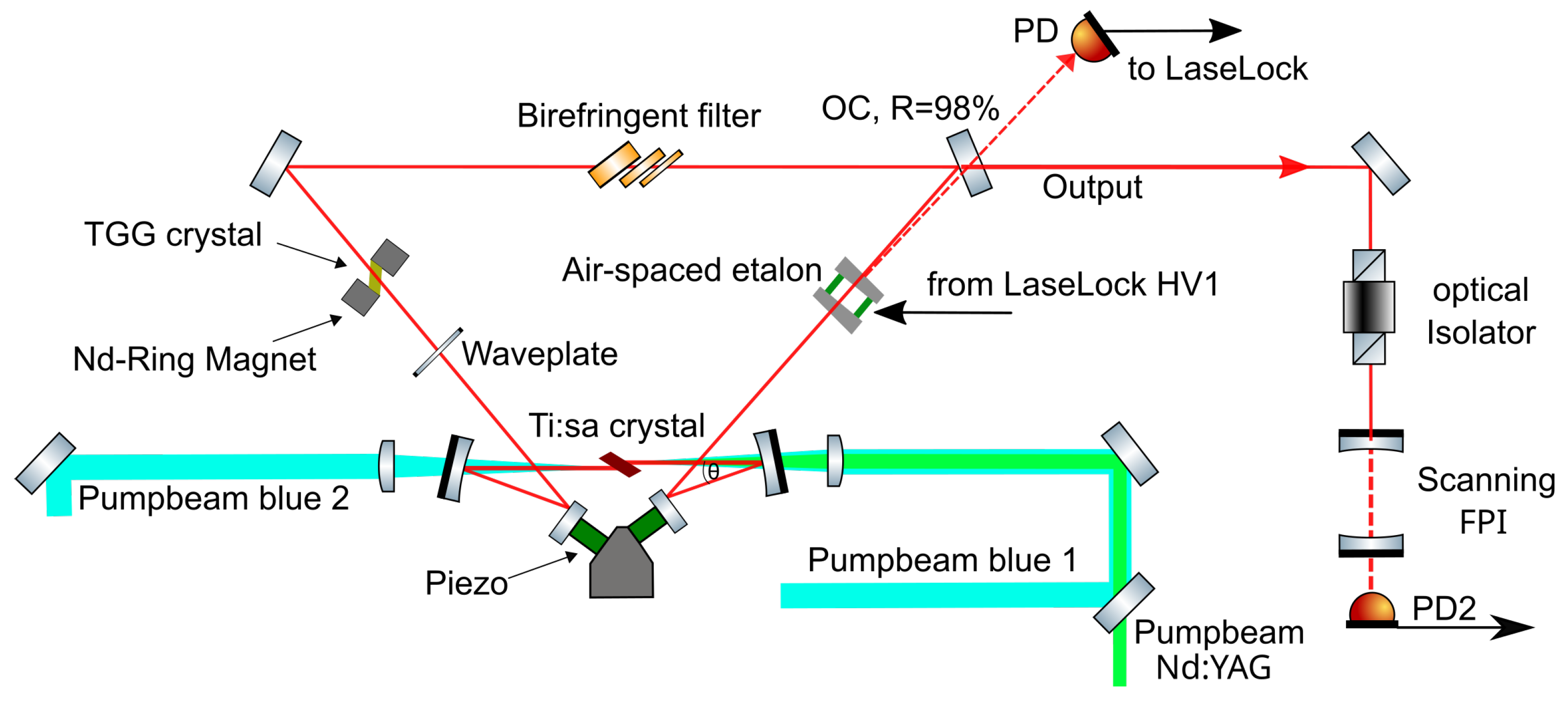

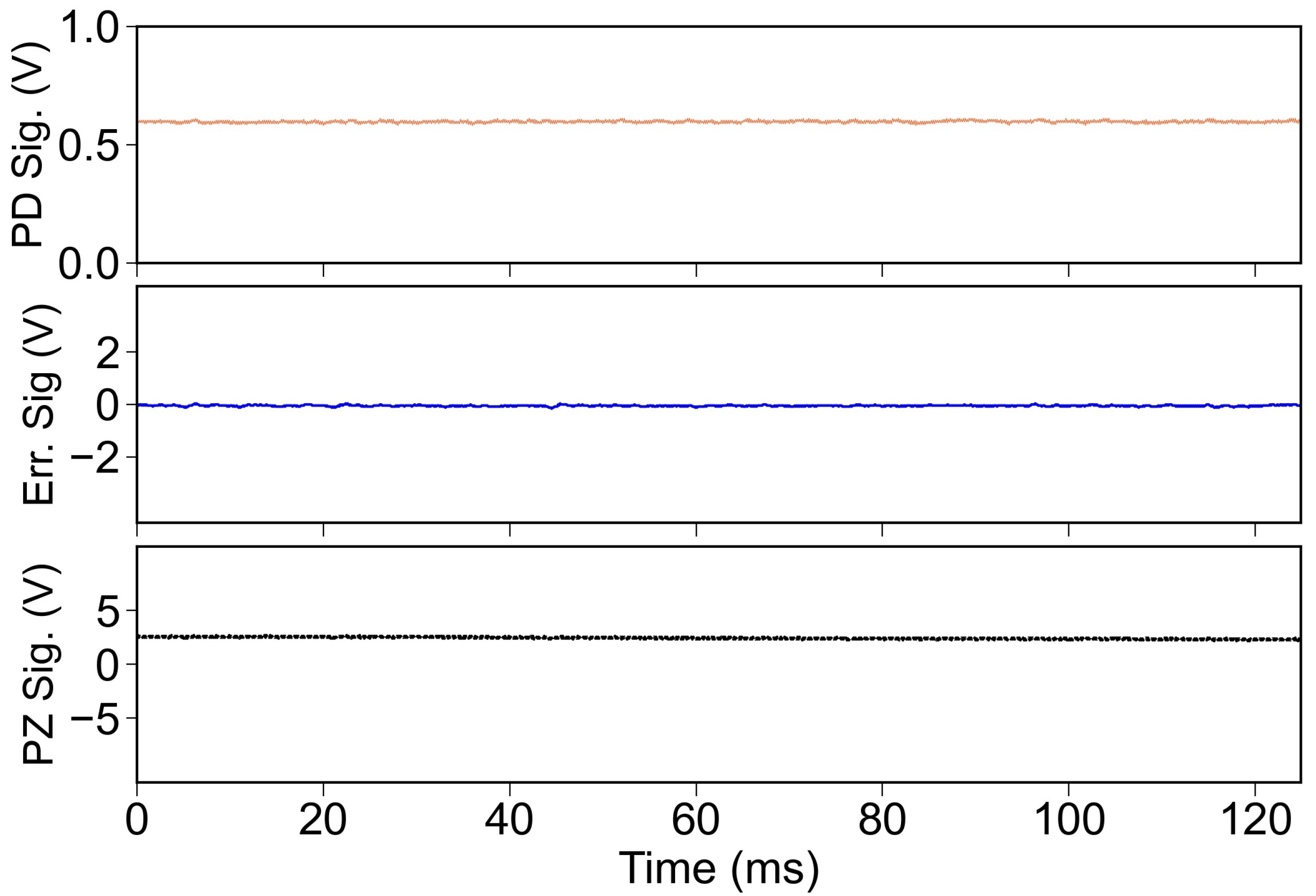
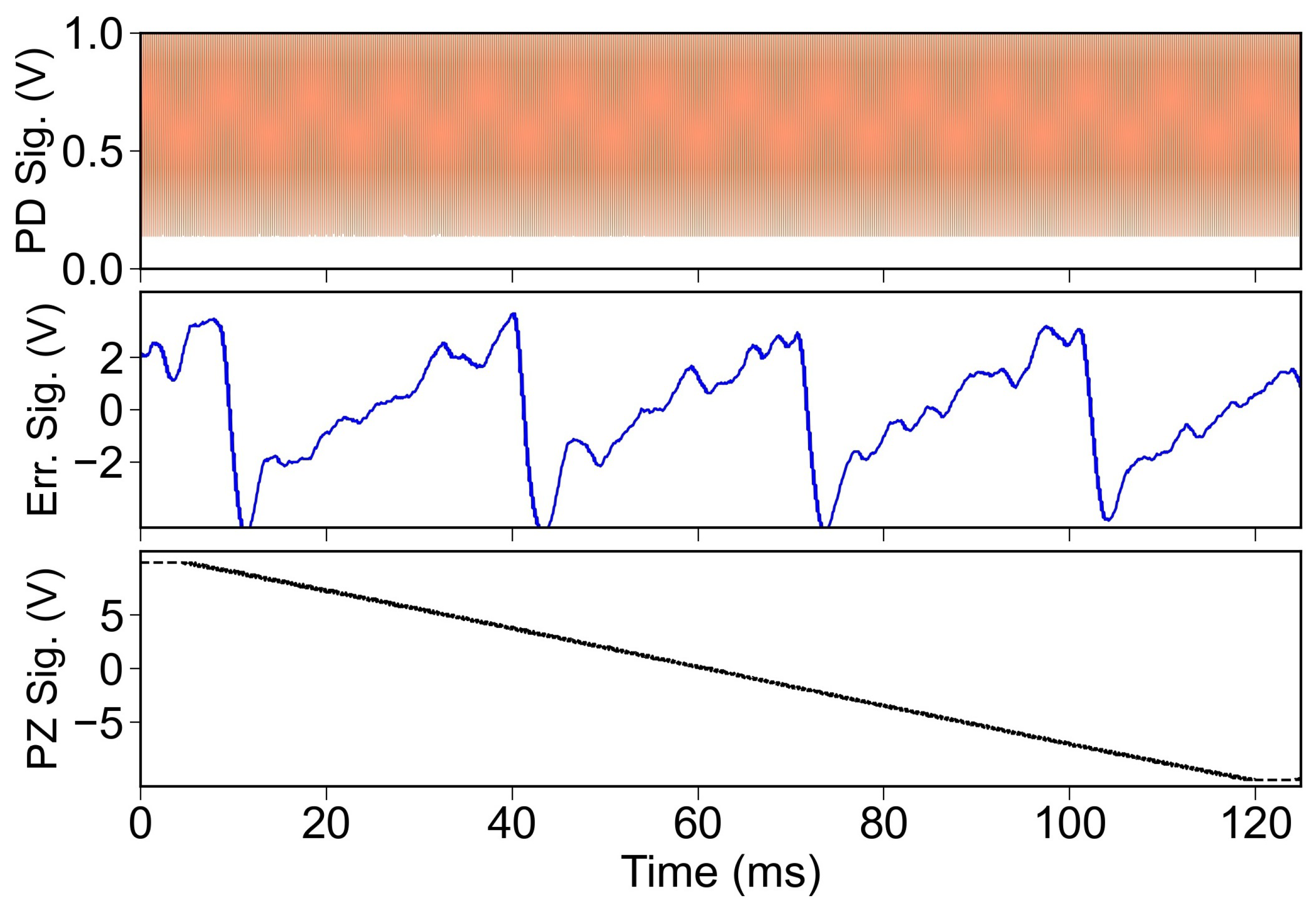
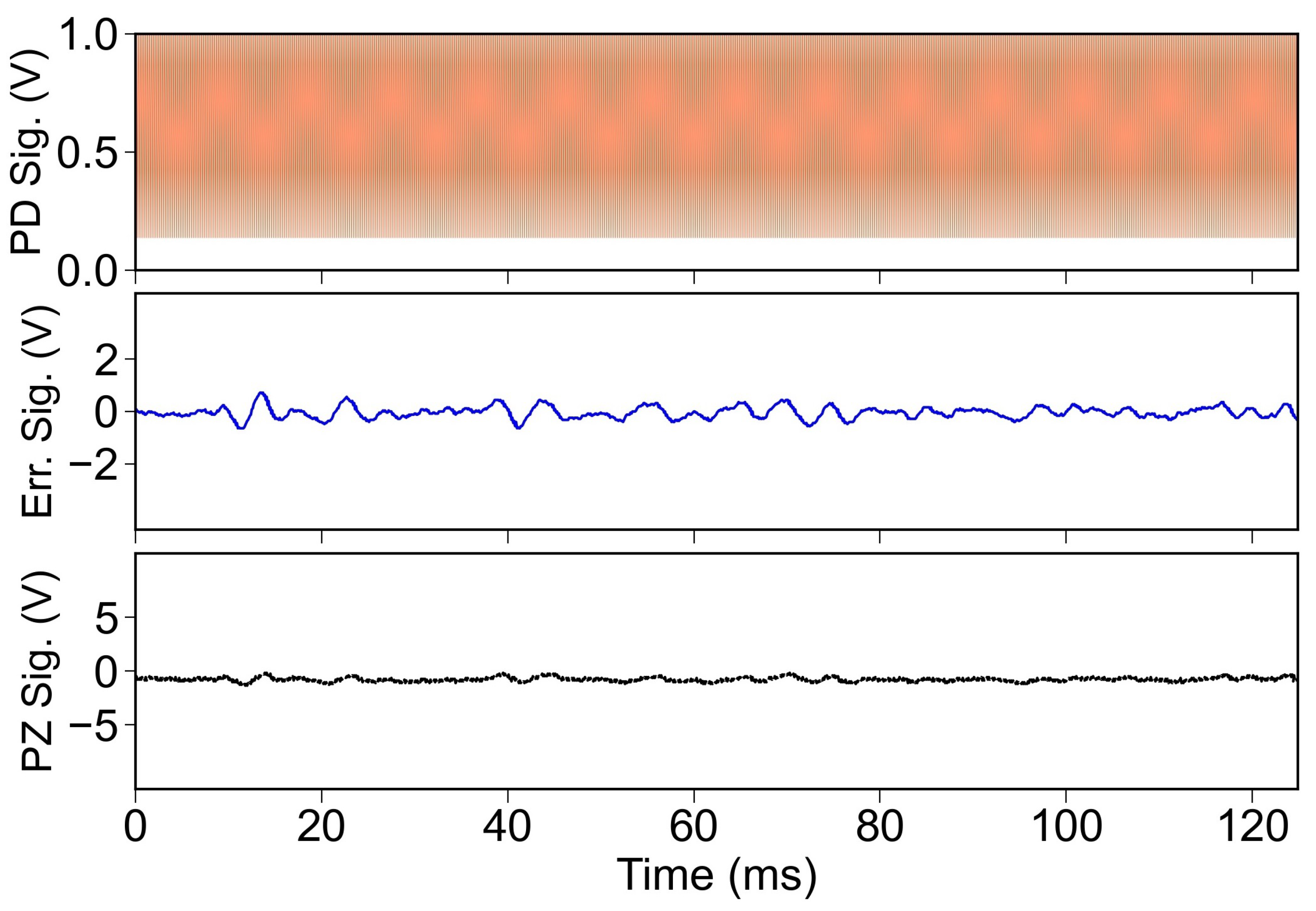

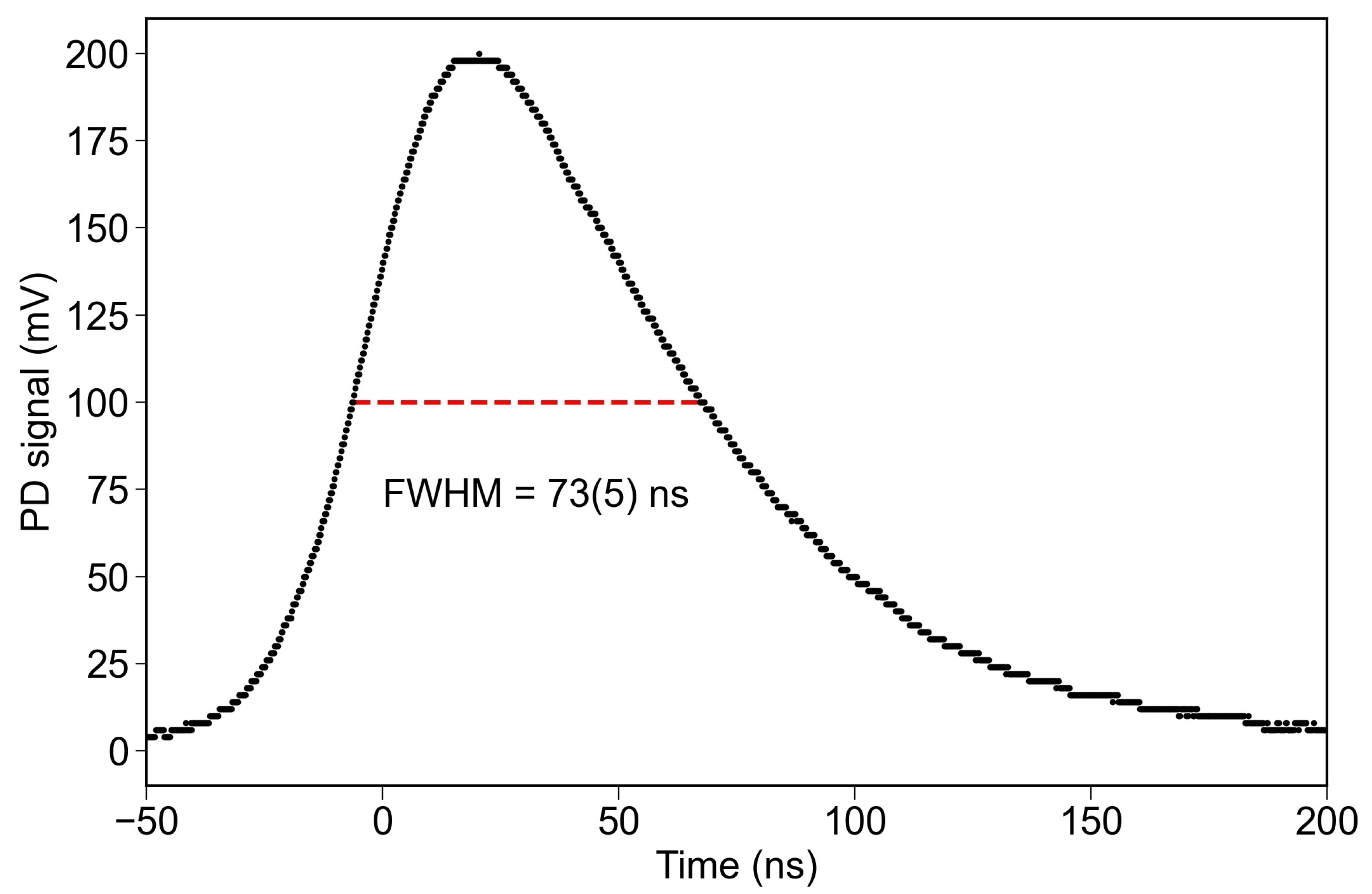
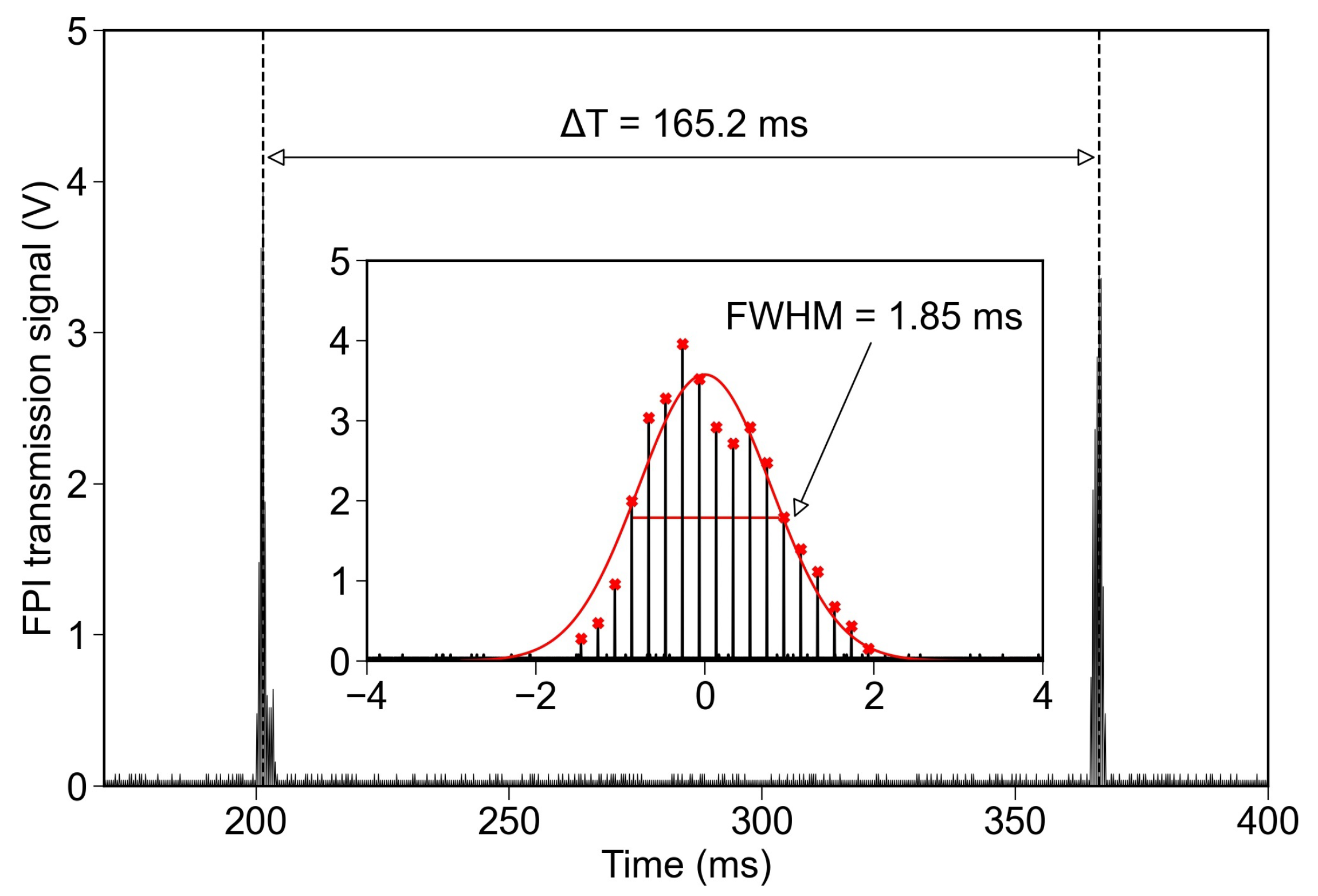
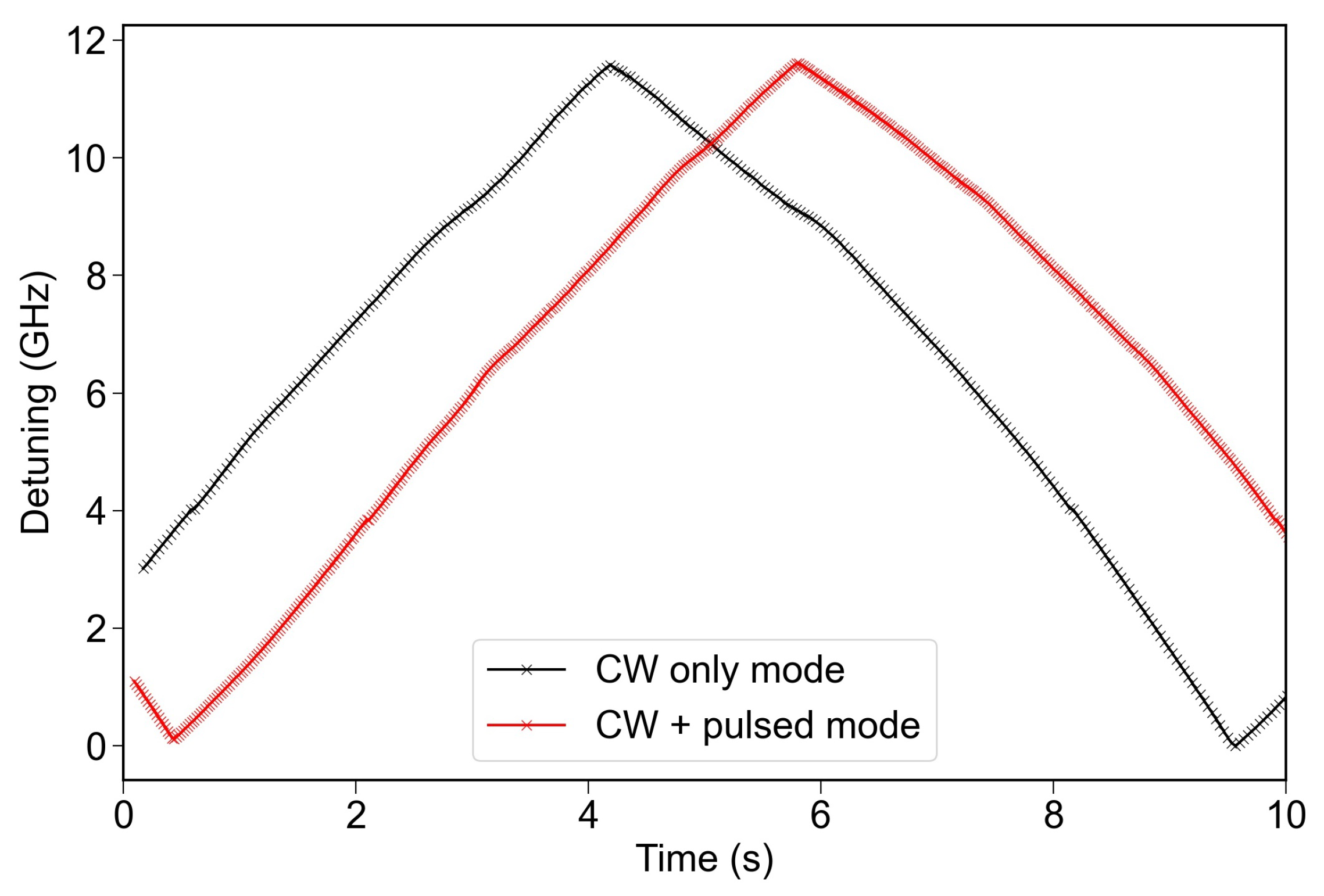
Publisher’s Note: MDPI stays neutral with regard to jurisdictional claims in published maps and institutional affiliations. |
© 2022 by the authors. Licensee MDPI, Basel, Switzerland. This article is an open access article distributed under the terms and conditions of the Creative Commons Attribution (CC BY) license (https://creativecommons.org/licenses/by/4.0/).
Share and Cite
Sonnenschein, V.; Tomita, H. A Hybrid Self-Seeded Ti:sapphire Laser with a Pumping Scheme Based on Spectral Beam Combination of Continuous Wave Diode and Pulsed DPSS Lasers. Appl. Sci. 2022, 12, 4727. https://doi.org/10.3390/app12094727
Sonnenschein V, Tomita H. A Hybrid Self-Seeded Ti:sapphire Laser with a Pumping Scheme Based on Spectral Beam Combination of Continuous Wave Diode and Pulsed DPSS Lasers. Applied Sciences. 2022; 12(9):4727. https://doi.org/10.3390/app12094727
Chicago/Turabian StyleSonnenschein, Volker, and Hideki Tomita. 2022. "A Hybrid Self-Seeded Ti:sapphire Laser with a Pumping Scheme Based on Spectral Beam Combination of Continuous Wave Diode and Pulsed DPSS Lasers" Applied Sciences 12, no. 9: 4727. https://doi.org/10.3390/app12094727
APA StyleSonnenschein, V., & Tomita, H. (2022). A Hybrid Self-Seeded Ti:sapphire Laser with a Pumping Scheme Based on Spectral Beam Combination of Continuous Wave Diode and Pulsed DPSS Lasers. Applied Sciences, 12(9), 4727. https://doi.org/10.3390/app12094727






